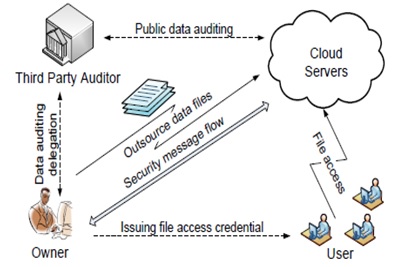Implementing Cloud Security through AWS for Blood Bank Application

DOI:
https://doi.org/10.54060/jieee.2023.81Keywords:
Cloud computing, Cloud Security, AWS Amplify, Android StudioAbstract
In today’s time the technologies are seeing a huge shift of work from the on-center to over the internet, which means that a huge number of online services is required, these services could be backup and the data recovery should be available over the internet. Cloud computing is the platform over the internet which provide the services of networking, sharing, storing, etc. on the internet. Not only this shift of data is being ob-served in IT sectors, but also this shift is being observed in the healthcare sector. With the increase in the average age limit of the human beings and new diseases increasing the medical needs. The traditional healthcare is now being replaced by modern and more progressive healthcare. Thus, cloud is providing with several healthcare solutions. How-ever, even after have a lot of benefits of using cloud services it also has some of the risks. The major risk being of the security of the patient’s data. This paper analyses the security issues and their possible countermeasures for the same. The security measures presented in the paper are based on patient data in relation to data storing, access and security of data. In the paper I have worked towards the development of the android application of blood bank, the application uses the Android studio as IDE and the AWS Amplify as the cloud service to host and deploy the application over the cloud. In this paper we will also see the benefits of using the cloud computing, its security and also what are the future works that need to be done in the field.
Downloads
References
H. Y. Kang, J. Y. Lee, and S.-Y. Noh, “A case study of cloud computing service models for the general computing environment in a university,” Int. J. Cloud Appl. Comput., vol. 12, no. 1, pp. 1–17, 2022.
M. Maliyaem, N. M. Tuan, D. Lockhart, and S. Muenthong, “A study of using machine learning in predicting COVID-19 cases,” Cloud Computing and Data Science, pp. 54–61, 2022.
Cloud computing market size, growth,” Fortunebusinessinsights.com. [Online]. Available: https://www.fortunebusinessinsights.com/cloud-computing-market-102697. [Accessed: 06-Jun-2022].
D. Ottenheimer and M. Wallace, Securing the virtual environment: How to defend the enterprise against attack, 1st ed. John Wiley & Sons, 2012.
D. Shekhawat and R. Ajmera, “Survey on Security Implication for the Downtime of VM in Cloud,” in Second World Conference on Smart Trends in Systems, Security and Sustainability, 2018.
L. B. Bhajantri and T. Mujawar, “A Survey of Cloud Computing Security Challenges, Issues and their Countermeasures,” in Third International Conference on I-SMAC (IoT in Social, Mobile, Analytics and Cloud) (I-SMAC), 2019.
Y. Sun, J. Zhang, Y. Xiong, and G. Zhu, “Data Security and Privacy in Cloud Computing,” International Journal of Dis-tributed Sensor Networks, vol. 10, no. 7, 2014.
K. Hashizume, D. G. Rosado, E. Fernández-Medina, and E. B. Fernandez, “An analysis of security issues for cloud computing,” J. Internet Serv. Appl., vol. 4, no. 1, p. 5, 2013.
M. Rabi Prasad Padhy and S. C. Ranjan Patra, “Cloud Computing: Security Issues and Research Chal-lenges”,” International Journal of Computer Science and Information Technology & Security, vol. 1, no. 2, pp. 136–146, 2011.
L. Ronaldo and R. D. Krutz, “Cloud Security A Comprehensive Guide to Secure Cloud Computing”,” Wiley India, pp. 147–148, 2010.
S. W. A. Rizvi and R. A. Khan, “Improving Software Requirements through Formal Methods,” International Journal of Infor-mation and Computation Technology, vol. 3, no. 11, pp. 1217–1223, 2013.
H. Parveen, A. Syed Wajahat, and P. Shukla, “Disease Risk Level Prediction using Ensemble Classifiers: An Algorithmic Analysis,” in IEEE Xplore INSPEC Accession Number: 21662591, 12th International Conference on Cloud Computing, 2022, pp. 585–590.
Amazon.com. [Online]. Available: https://docs.aws.amazon.com/amplify/latest/userguide/security.html. [Accessed: 06-Jun-2022].
R. Charanya , M. Aramudhan , K. Mohan, S. Nithya, ”Levels of Security Issues in Cloud Computing,” In International Journal of Engineering and Technology (IJET) ,vol. 5, no. 2, pp. 1912-1920, 2013.
P. R. Kumar, P. H. Raj, and P. Jelciana, “Exploring data security issues and solutions in cloud computing,” Procedia Comput. Sci., vol. 125, pp. 691–697, 2018.
Y. S. Lee, N. Bruce, T. Non, E. Alasaarela, and H. Lee, “Hybrid cloud service based healthcare solutions,” in 2015 IEEE 29th In-ternational Conference on Advanced Information Networking and Applications Workshops, 2015.
R. Marcu and D. Popescu, “Security solution for healthcare hybrid cloud platform,” in 2014 18th International Conference on System Theory, Control and Computing (ICSTCC), 2014.
M. R. Lyu, Handbook of Software Reliability Engineering. Los Alamitos, California: IEEE Computer Society Press, 1996.
Ritu, K. Solanki, A. Dhankhar, and S. Dalal, “An analysis of software reliability estimation using fuzzy logic function with cocomo ii model,” Int. J. Comput. Sci. Eng., vol. 7, no. 6, pp. 623–626, 2019.
R. A. Khan, K. Mustafa, and S. I. Ahson, Operation Profile-a key Factor for Reliability Estimation. University Press, 2004.

Downloads
Published
How to Cite
CITATION COUNT
License
Copyright (c) 2023 Apoorva Srivastava, Dr. Syed Wajahat Abbas Rizvi, Rashmi Priya

This work is licensed under a Creative Commons Attribution 4.0 International License.

























